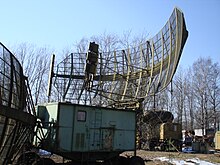P-35 (radar device)
P-35 was the abbreviation for a 2D radar device for all-round search from Soviet production with the Russian code name "Saturn" (Cyrillic: П-35 "Сатурн").
development
The manufacturer was the combine "LEMS" ( Russian НПО "Лианозовский электромеханический завод" , Electromechanical Plant Lianosowo), the manufacturer designation 1RL110 and the NATO designation "Bar Lock". The name of the radar family (radar class) was "Drainage" (Cyrillic: "Дренаж"). The P-35 was introduced into the troops around 1958 and was also used in the former NVA with the radio technical troops for air reconnaissance and fighter control. The crew of this reconnaissance radar consisted of 6 to 8 people.
The P-35 was developed from the previous P-30 model. The transmission / reception booth was mounted on the mount of a 100 mm anti-aircraft gun. With the new turning reporting system , a side angle accuracy of 6 arc minutes was achieved when turning. The P-35 could be relocated tactically. With a trained team of 8 people, the standard time to get ready for laying was 12 hours.
The typical V-beam position of the two antennas of the P-30 for determining the height was dispensed with on the P-35. Both parabolic antennas were brought into a horizontal position. The upper antenna received two horn antennas, the lower antenna four. All six frequencies were broadcast at a different elevation angle. Altogether the elevation angles from 0 ° to + 28 ° were covered. The height of the two parabolic mirrors could be adjusted mechanically so that the antenna diagram could be adapted to the terrain (angle of coverage). A basic determination of the height was possible by briefly switching off individual receivers. This made it possible to identify the transmitter that displayed the target on the screen. In practical work, however, this was seldom done because this procedure was simply too time-consuming.
| Technical data P-35 "Bar Lock" | |
|---|---|
| Frequency range | 2.7-3.3 GHz |
| Pulse repetition time | |
| Pulse repetition frequency | 375 Hz |
| Transmission time (PW) | 1.5 or 4.5 µs |
| Reception time | |
| Dead time | |
| Pulse power | 6 times 700 kW each |
| Average performance | 6 times 700 W each |
| displayed distance | up to 350 km |
| Distance resolution | |
| Opening angle | 2 ° |
| Hit count | > 8 |
| Antenna round trip time | 10 or 20 s |
There were a total of four modernizations of the P-35 (P-35M, P-35M2, P-35M3, P-35M4) before the modernizations led to the new P-37 radar device . Of the 6 transmitters, only 5 were incorporated into the further developed model. Instead of the 6th transmitter with the lowest frequency, the "Active Response" system, a special secondary radar that was needed to guide the new MiG-21 , was installed in the P-37's transmitting / receiving cabin .
Web links
Individual evidence
- ↑ Vestnik PVO , magazine for military technology
- ↑ Togliatti Technical Museum
- ↑ www.globalsecurity.org

